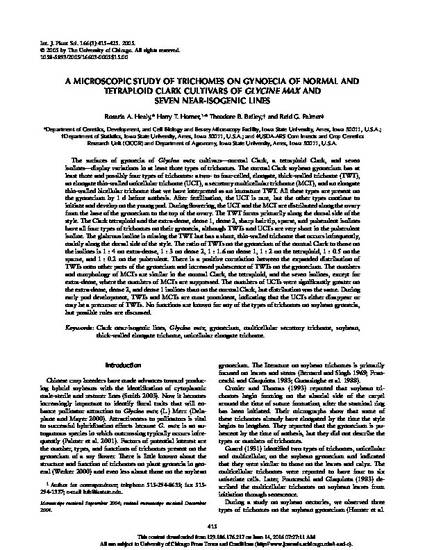
Article
A microscopic study of the trichomes on gynoecia of normal and tetraploid Clark cultivars of Glycine max and seven near isogenic lines
International Journal of Plant Sciences
Document Type
Article
Disciplines
Publication Version
Published Version
Publication Date
5-1-2005
DOI
10.1086/428632
Abstract
The surfaces of gynoecia of Glycine max cultivars—normal Clark, a tetraploid Clark, and seven isolines—display variations in at least three types of trichomes. The normal Clark soybean gynoecium has at least three and possibly four types of trichomes: a two‐ to four‐celled, elongate, thick‐walled trichome (TWT), an elongate thin‐walled unicellular trichome (UCT), a secretory multicellular trichome (MCT), and an elongate thin‐walled bicellular trichome that we have interpreted as an immature TWT. All these types are present on the gynoecium by 1 d before anthesis. After fertilization, the UCT is rare, but the other types continue to initiate and develop on the young pod. During flowering, the UCT and the MCT are distributed along the ovary from the base of the gynoecium to the top of the ovary. The TWT forms primarily along the dorsal side of the style. The Clark tetraploid and the extra-dense, dense 1, dense 2, sharp hair tip, sparse, and puberulent isolines have all four types of trichomes on their gynoecia, although TWTs and UCTs are very short in the puberulent isoline. The glabrous isoline is missing the TWT but has a short, thin‐walled trichome that occurs infrequently, mainly along the dorsal side of the style. The ratio of TWTs on the gynoecium of the normal Clark to those on the isolines is 1:4 on extra-dense, 1:3 on dense 2, 1:1.6 on dense 1, 1:2 on the tetraploid, 1:0.5 on the sparse, and 1:0.2 on the puberulent. There is a positive correlation between the expanded distribution of TWTs onto other parts of the gynoecium and increased pubescence of TWTs on the gynoecium. The numbers and morphology of MCTs are similar in the normal Clark, the tetraploid, and the seven isolines, except for extra-dense, where the numbers of MCTs are suppressed. The numbers of UCTs were significantly greater on the extra-dense, dense 2, and dense 1 isolines than on the normal Clark, but distribution was the same. During early pod development, TWTs and MCTs are most prominent, indicating that the UCTs either disappear or may be a precursor of TWTs. No functions are known for any of the types of trichomes on soybean gynoecia, but possible roles are discussed.
Rights
Works produced by employees of the U.S. Government as part of their official duties are not copyrighted within the U.S. The content of this document is not copyrighted.
Language
en
File Format
application/pdf
Citation Information
Rosaria A. Healy, Harry T. Horner, Theodore B. Bailey and Reid G. Palmer. "A microscopic study of the trichomes on gynoecia of normal and tetraploid Clark cultivars of Glycine max and seven near isogenic lines" International Journal of Plant Sciences Vol. 166 Iss. 3 (2005) p. 415 - 425 Available at: http://works.bepress.com/harry-horner/60/

This article is from International Journal of Plant Sciences 166 (2005): 415, doi: 10.1086/428632.